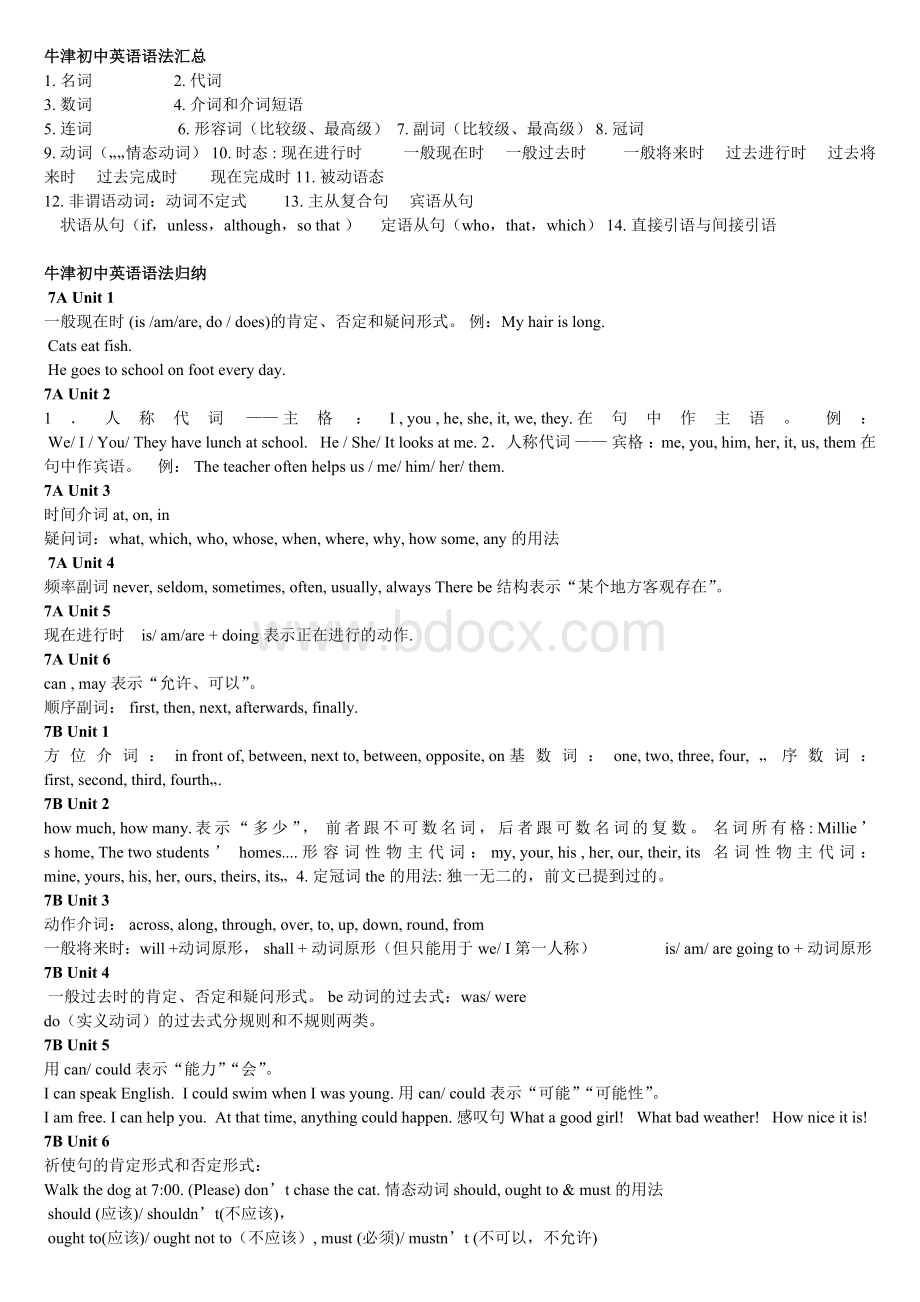牛津初中英语语法汇总.doc
《牛津初中英语语法汇总.doc》由会员分享,可在线阅读,更多相关《牛津初中英语语法汇总.doc(4页珍藏版)》请在冰豆网上搜索。

牛津初中英语语法汇总
1. 名词 2. 代词
3. 数词 4. 介词和介词短语
5. 连词 6. 形容词(比较级、最高级) 7. 副词(比较级、最高级) 8. 冠词
9. 动词(„„情态动词) 10. 时态 :
现在进行时 一般现在时 一般过去时 一般将来时 过去进行时 过去将来时 过去完成时 现在完成时 11. 被动语态
12. 非谓语动词:
动词不定式 13. 主从复合句 宾语从句
状语从句(if,unless,although,so that ) 定语从句(who,that,which) 14. 直接引语与间接引语
牛津初中英语语法归纳
7A Unit 1
一般现在时 (is /am/are, do / does)的肯定、否定和疑问形式。
例:
My hair is long.
Cats eat fish.
He goes to school on foot every day.
7A Unit 2
1.人称代词 —— 主格 :
I , you , he, she, it, we, they. 在句中作主语。
例:
We/ I / You/ They have lunch at school. He / She/ It looks at me. 2.人称代词 —— 宾格 :
me, you, him, her, it, us, them在句中作宾语。
例:
The teacher often helps us / me/ him/ her/ them.
7A Unit 3
时间介词 at, on, in
疑问词:
what, which, who, whose, when, where, why, how some, any 的用法
7A Unit 4
频率副词 never, seldom, sometimes, often, usually, always There be 结构表示“某个地方客观存在”。
7A Unit 5
现在进行时 is/ am/are + doing 表示正在进行的动作.
7A Unit 6
can , may表示“允许、可以”。
顺序副词:
first, then, next, afterwards, finally.
7B Unit 1
方位介词:
in front of, between, next to, between, opposite, on 基数词:
one, two, three, four,„ 序数词:
first, second, third, fourth„.
7B Unit 2
how much, how many.表示“多少”, 前者跟不可数名词,后者跟可数名词的复数。
名词所有格:
Millie’s home, The two students’ homes.... 形容词性物主代词:
my, your, his , her, our, their, its 名词性物主代词:
mine, yours, his, her, ours, theirs, its„ 4. 定冠词the的用法:
独一无二的,前文已提到过的。
7B Unit 3
动作介词:
across, along, through, over, to, up, down, round, from
一般将来时:
will +动词原形, shall + 动词原形(但只能用于we/ I 第一人称) is/ am/ are going to + 动词原形
7B Unit 4
一般过去时的肯定、否定和疑问形式。
be 动词的过去式:
was/ were
do(实义动词)的过去式分规则和不规则两类。
7B Unit 5
用can/ could表示“能力”“会”。
I can speak English. I could swim when I was young. 用can/ could 表示“可能”“可能性”。
I am free. I can help you. At that time, anything could happen. 感叹句 What a good girl!
What bad weather!
How nice it is!
7B Unit 6
祈使句的肯定形式和否定形式:
Walk the dog at 7:
00. (Please) don’t chase the cat. 情态动词should, ought to & must 的用法
should (应该)/ shouldn’t(不应该),
ought to(应该)/ ought not to(不应该), must (必须)/ mustn’t (不可以,不允许)
8A Unit 1
1. 描述性形容词,如:
short, long, round, interesting,funny, slim, important, beautiful等。
2.形容词的比较级和最高级 ① 规则的bigger / the biggest more important/ the most important
② 不规则的 worse / the worst
表示“比较”的句式:
as + 形容词+as ----- “和。
。
。
一样” not as / so + 形容词 + as——“。
。
。
。
不如。
。
。
”
8A Unit 2
比较两者间的数量用以下句式:
more„.than, fewer„.than., less„ than 例:
I have more / fewer apples than you. (后跟复数名词)
I have more / less free time than he/ him.(后跟不可数名词) 2.比较两者以上间的数量用 the most, the fewest, the least. 例:
Amy scored the most/ fewest points of all. Daniel has the least money of the three.. 3.用 like & alike 来比较。
例:
My skirt is / looks like hers. = My skirt and hers are alike. 4. 用词组 the same as & be different from来比较
8A Unit 3
1. and, but, or(或者)的用法。
2. 动词+ to do 这些动词有:
plan, agree, want, decide, choose, hope, learn, prepare等。
3.反身代词:
myself, yourself, yourselves, ourselves, himself, herself, itself, themselves
8A Unit 4
由if引导的条件状语从句
1. 用来描述可能出现的情况,主句时态用将来时,如:
If it doesn’t rain tomorrow, we will go to the park..
2.用来描述反复的、可预见的情况,主句时态用一般时。
如:
If tigers are hungry, they attack people.
8A Unit 5
1. 用一般现在时表示“将来”。
如:
The train leaves at 9:
00. 2.用现在进行时表示“将来”,如:
We are leaving for Shanghai this evening. 3.方式副词:
quietly, gently, easily, well„往往由形容词+ly变成副词,如:
quiet – quietly, easy—easily, possible – possibly 少数副词和形容词同形,如:
fast, early, long 等。
注意:
good—well, near—nearly , hard -- hardly
8A Unit 6
1. 表示原因的连词:
because , as, since. (这些词放在原因从句之前,主句不能再用so.) 2.表示命令、请求、建议的句式:
tell / ask / order /advise / warn sb. (not) to do sth.
8B Unit 1 现在完成时
结构:
have / has + PP 表示动作发生在过去但对现在仍有影响。
肯定、否定和疑问形式
常用的一些时间状语,如:
already, ever, for, since, just, never, yet等。
for + 一段时间, since + 过去的一点时间/ 用过去式的从句,相对应的主句动词要用延续性动词,如:
leave --- be away, die --- be dead, borrow ---- keep, buy—have, come ---be here, join –- be in/ be a member of 等。
如:
He has left already.
He has been away for two hours.
8B Unit 2
1. 过去进行时 was / were + doing 表示过去某个时刻正在进行的 。
2. 肯定、否定和疑问形式.
3. while 和 when在过去进行时中的用法:
进行时+ while +进行时
过去式,while + 进行时 = when +过去式,进行时
例:
I was doing my homework while my father was watching TV..
The bell rang while he was reading books.
When the bell rang, he was reading books. (以上这两句主从句前后可以互换)
8B Unit 3 被动语态
结构:
be + PP 时态变化都只改变be 的各种形式 肯定、否定和疑问形式
不是所有的动词都有被动形式,如感觉动词:
feel, smell, look, taste, sound 和 happen, take place 等。
主动形式表被动意义,如:
This shirt sells well. (详细见课件复习)
8B Unit 4
because, because of, so 的用法。
because + 从句, because of +短语 (but:
what you said), 两者后都跟原因。
so 后跟结果的从句。
同一句子中,不能同时出现because/ because of和 so. 2.hope & wish的用法
hope 所希望的是有可能实现的,但wish所希望的是现在不可能实现的。
如:
I hope you can come to my party.
I wish I were the Presi